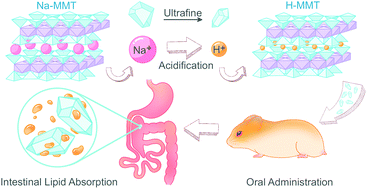A versatile ultrafine and super-absorptive H+-modified montmorillonite: application for metabolic syndrome intervention and gastric mucosal protection†
Abstract
Metabolic syndrome (MetS) includes central obesity, hypertension, insulin resistance, and dyslipidemia and is closely related to nonalcoholic fatty liver disease, atherosclerotic cardiovascular disease (CVD) and type 2 diabetes mellitus, involving multiple causative factors. Current drug therapies for intervention and amelioration of MetS are essential in clinical treatment of metabolic disease. In this report, we proposed an H+-modified montmorillonite (H-MMT) using an acid modification method with ultrafine structure and super absorption ability as a potential drug for MetS. Hamsters fed a high-fat diet were orally treated with H-MMT and simvastatin was applied as a control. H-MMT lowered lipids by decreasing intestinal absorption and promoting lipid excretion, subsequently preventing obesity, fatty liver, and hyperlipidemia. Moreover, H-MMT was significantly safer and better tolerated by the liver compared to simvastatin, which was hepatotoxic. In addition, we found that H-MMT had protective effects on gastric mucosal damage. Therefore, this versatile H-MMT provides a potential strategy to effectively improve MetS and provide gastric mucosal protection in clinical applications.



 Please wait while we load your content...
Please wait while we load your content...